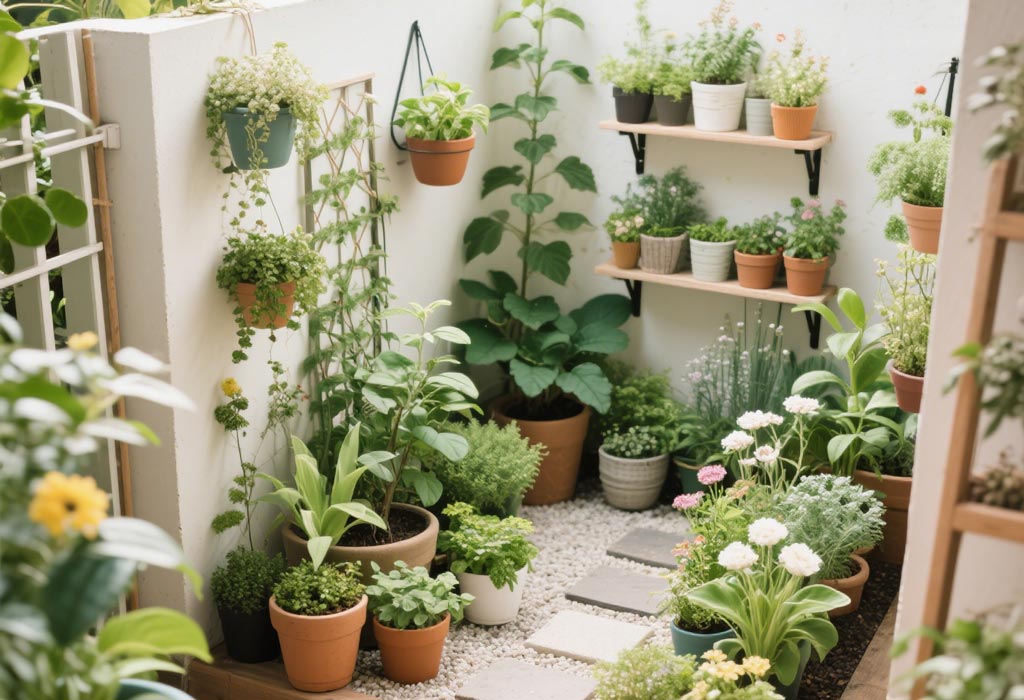Urban living doesn’t have to mean sacrificing fresh herbs, juicy tomatoes, or vibrant blooms. With 68% of the global population projected to reside in cities by 2050 (UN), apartment gardening has evolved from a niche hobby into a revolutionary act of self-sufficiency. This guide unveils science-backed strategies to transform cramped balconies, windowsills, and even walls into thriving edible and ornamental paradises.
1. The Rise of Urban Gardening: More Than a Trend
The pandemic ignited a 200% surge in seed sales (National Gardening Association, 2021), as city dwellers sought solace and food security. But small-space gardening isn’t new:
- Historical precedent: Ancient Babylon’s Hanging Gardens (600 BCE) pioneered vertical growing.
- Modern drivers: Rising grocery prices (14% YoY increase for produce in 2023) and pesticide concerns.
- Mental health perks: A 2022 Urban Forestry study linked balcony gardening to reduced anxiety and improved sleep quality.
2. Container Gardening 101: Maximizing Limited Square Footage
A. Choosing the Right Plants
Vegetables & Fruits:
- Fast growers: Radishes (25 days), baby spinach (30 days), bush beans (50 days).
- Compact varieties:
- ‘Tiny Tim’ tomatoes (12-inch plants).
- ‘Patio Snacker’ cucumbers (ideal for 5-gallon pots).
- ‘Fairy Tale’ eggplants (18-inch height).
Flowers for Pollinators:
- Shallow-rooted: Marigolds, pansies, nasturtiums (edible blooms).
- Fragrant: Dwarf jasmine, lavender ‘Lady Anne’.
B. Container Science
- Material matters:
- Plastic: Lightweight but prone to overheating.
- Fabric pots: Air-prune roots; prevent waterlogging (10–10–25).
- Self-watering planters: Reservoirs reduce frequency (e.g., EarthBox, $60).
- Size guidelines:CropMinimum Pot DepthLettuce6 inchesPeppers12 inchesDwarf citrus18 inches
3. Vertical Gardening: Reclaiming Wall and Air Space
A. DIY Systems for Renters
- Pallet Gardens (Cost: 0–0–20):
- Sand a discarded pallet.
- Line slats with landscape fabric.
- Fill with soil; plant herbs like thyme and oregano.
- Hanging Gutters:
- Mount vinyl gutters ($8/10ft) beneath windows.
- Grow strawberries or trailing petunias.
- Magnetic Planters (IKEA KRYDDA/VÄXER series):
- Attach to steel surfaces (e.g., fridge sides).
- Perfect for microgreens.
B. Commercial Solutions
- GreenStalk Vertical Planter: 5-tier system holds 30 plants ($149).
- Vivosun Trellis Netting: Support climbing beans/peas ($16).
4. Conquering Light Challenges in Urban Jungles
A. Assessing Your Space
- Sun mapping: Use apps like Sun Surveyor to track daily exposure.
- Light categories:
- Full sun: 6+ hours (south-facing balconies).
- Partial shade: 3–6 hours (east/west windows).
- Full shade: <3 hours (north-facing or enclosed patios).
B. Artificial Lighting Hacks
- Budget option: GE Balanced Spectrum LED bulbs (5000K, $15/pack) in clip lamps.
- Advanced setups:
- Spider Farmer SF-1000: Full-spectrum panel for 2x2ft areas ($159).
- Timer settings: 14–16 hours/day for veggies; 8–10 hours for succulents.
Pro Tip: Line walls with reflective Mylar sheets ($20/roll) to amplify natural light by 30%.
5. Water Wisdom: Avoiding Over- and Underwatering
- Self-watering spikes: Terracotta stakes (e.g., Blumat, $25) wick moisture from bottles.
- The “knuckle test”: Water when the top 1–2 inches of soil feel dry.
- Rainwater harvesting: Collapsible 5-gallon barrels ($40) fit small balconies.
Weekly Watering Schedule Example (For 70°F–80°F):
| Plant | Frequency | Amount |
|---|---|---|
| Basil | Every 2d | 1 cup |
| Succulents | Every 10d | ½ cup |
| Ferns | Every 3d | 2 cups |
6. Navigating Legal and Social Hurdles
A. HOA/Lease Compliance
- Weight limits: Soil-filled pots weigh 12–18 lbs/gallon. Check balcony load capacity (usually 50–100 lbs/sq ft).
- Drip trays: Prevent water damage to neighbors below ($5 plastic saucers).
- Fire codes: Avoid blocking exits/windows; use non-flammable trellis materials.
B. Community Resources
- Seed libraries: 600+ U.S. libraries offer free seeds (e.g., Richmond Public Library).
- Tool sharing apps: Share pruners/tillers via Neighborhood or Nextdoor.
7. Case Study: A 300 Sq Ft Studio’s Bounty
Location: Brooklyn, NY | Space: 4x6ft balcony + 3 windowsills
| Crop | Yield (2023 Season) | Notes |
|---|---|---|
| Cherry tomatoes | 18 lbs | ‘Tumbling Tom’ variety |
| Kale | 4 lbs/month | Harvested outer leaves |
| Mint | 2 cups/week | Used for tea & cocktails |
Total annual savings: $420 on groceries.
8. Troubleshooting Common Issues
- Pests:
- Aphids: Spray with 1 tsp dish soap + 1 quart water.
- Fungus gnats: Cover soil with ½” sand to block larvae.
- Wind damage: Secure tall plants with bamboo stakes and plant velcro ($8).
- Soil depletion: Refresh 30% of potting mix each season; add worm castings ($12/bag).
9. Winter Gardening: Extending the Season
- Cold frames: Convert IKEA bookshelves into mini-greenhouses with PVC and plastic sheeting ($50).
- Grow tent kits: Vivosun 2x4ft tent + LED light ($220) for year-round salads.
- Frost cloth: Protect plants down to 28°F ($0.50/sq ft).
10. The Future of Urban Agriculture
From hydroponic smart gardens (e.g., Click & Grow, $99) to robotic pollinators, technology is democratizing access to hyper-local food. Yet, the core principle remains: Even a single pot of basil on a fire escape proves that where there’s a will—and sunlight—there’s a harvest.















